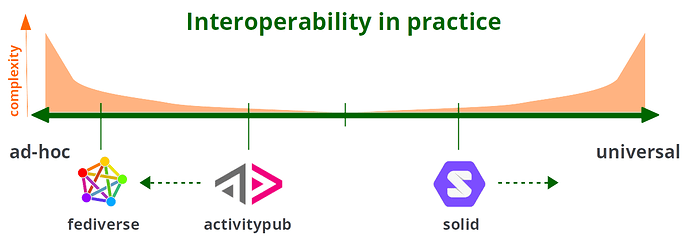Apologies for the extremely delayed reply, I missed this back in January, as I was out of action that month.
Anyway, hey, hi! I’m Emelia, I currently work on the developer tools team over at Inrupt (the company founded by timbl to build Solid for the enterprise).
This thread strikes a cord with me, as I’ve been doing my best to learn RDF & Linked Data over the past year. I don’t come from an RDF, Linked Data or Academic background; instead my background is in working with startups (~23 to date) to build out their products, and in building tools & platforms for developers to be as productive as possible. I’ve also significant experience with building both frontend and backend applications, and a wealth of production knowledge on GraphQL and Node.js.
I could not agree more that the biggest hurdle developers will face in adopting Linked Data is it’s background in RDF.
Mainstream developers typically choose the option with the least friction possible, they want the API to work and work how they want it to, without having to learn for years to feel proficient in what they’re doing. In reality, code and standards are like a barrier between them and their paycheck & getting home at a reasonable time, and keeping their product manager off their back as to why something isn’t done yet.
And that’s coming from someone who’s usually working with more modern tech stacks (react, redux, graphql, json APIs, webpack, nest.js, typescript, etc). I’ve spent a bunch of time trying to help developers towards actually using schema-driven APIs, and it’s always a challenge, you’ll often have different teams wanting to do things “their way” rather than working in unison & trusting that the other team knows what they’re doing.
In previous conversations, I’ve kinda jokingly said “RDF is highly structured, schemaless, garbage that you may find useful data in”, by which I mean, you’ve no guarantees with what you get in RDF, you might get a single value, multiple, or none at all, you might get a certain “field” (predicate), but you may also not.
This is very different to how most developers are used to working where by they can make assumptions that their API returns back data in the way they want, or if not, they hack through whatever “crap” the backend developers have sent them to make their applications “work” and satisfy the product requirements.
This is where a lot of developers find frustration in working with TypeScript and data coming from APIs, because JSON.parse returns an any rather than the structure that they think they know they are receiving from the API. It’s quite rare to see developers actually validate and check the shape of the data they’ve gotten back from their API — the most you usually see is a response.status === 200 check, and then just response.json() with maybe a try/catch around the asynchronous network call.
Even just getting developers to write consistent GraphQL schemas is challenging, and often requires a lot of training & guiding towards helping them understand what they’re working with, and how it can help them, instead of fighting the tool or library.
There are newer approaches that are starting to improve the situation, such as Zod, GraphQL-Codegen, JSON-RPC or tRPC, and some JSON Schema tooling, but adoption is only just barely happening, there’s a lot of practices to unlearn.
I also know in the Linked Data world we’ve ShEx and Shacl, both of which try to enforce at least some sort of schema on top of RDF data. I definitely think the “killer” platform for getting developers to adopt RDF, Linked Data, etc, is going to be one that takes them from their practices today, and bridges the gaps & hides the complexities. For instance, this might be using GraphQL schemas & operations (queries & mutations) in their Schema Definition Language, to generate essentially an API for their data that they want — Jesse Wright, a coworker at Inrupt, actually has a prototype . Another option might be a tool to transform JSON Schema’s into Shacl/ShEx, or do similar code generation as previously described.
But I don’t think majority of developers will seriously work with lower level interactions with Linked Data (e.g., interacting directly with JSON-LD, Turtle, Quads, etc). Those will be more used by tooling developers or experts who know what they’re doing (or beginners who don’t yet know what they’re doing at all, and make many mistakes due to not knowing better).
I hope this can hopefully add to the conversation here, and perhaps a different perspective. (And hopefully no one is highly offended by my joking description of RDF, I’ve just seen far too many people struggling to get their heads around it’s quirks, even people who would normally be writing database migration & actually schema driven data)
(these are my own opinions and do not necessarily reflect the standing of my employer)
